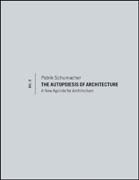
The autopoiesis of architecture: a new agenda for architecture v. II
Schumacher, Patrik
Whereas the first volume of this set provides the intellectual groundwork forSchumacher's ideas, the second volume addresses the specific, contemporary challenges that architecture faces. It formulates these tasks, looking specifically at how architecture organizes and articulates the complexity of post-fordist network society. This addresses how current architecture can upgrade its design methodology for an increasingly demanding task environment, characterizedby both complexity and novelty. Architecture's role within contemporary society is explained and its relationship to politics is clarified. Finally, the emerging new style of Parametricism is introduced and theoretically grounded. INDICE: Introduction to Volume 26. The Task of Architecture6.1 Functions6.1.1 Functions versus Capacities6.1.2 Substantial versus Subsidiary Functions6.1.3 Tectonics6.1.4 The Categorization of Function-types6.1.5 Problem-types (Function-types) vs Solution-types (Archetypes)6.1.6 Patterns of Decomposition/Composition6.1.7 Functional Reasoning via Action-artefacts Networks6.1.8 Limitations of Functional Expertise6.2 Order via Organization and Articulation6.2.1 Organization and Articulation: Historical and Systematic6.2.2 Architectural Order6.2.3 A Definition of Organization for Contemporary Architecture6.2.4 Complicated, Complex, Organized, Ordered6.3 Organization6.3.1 Relating Spatial to Social Organization6.3.2 Territorialization and Integration6.3.3 Systems, Configurations, Organizations6.4 Supplementing Architecture with a Science of Configuration6.4.1 Set Theory6.4.2 Harnessing Network Theory (Graph Theory)6.4.3 Excursion: Network Theory (Graph Theory)6.4.4 A City is not a Tree6.4.5 Space Syntax: Concepts and Tools of Analysis6.4.6 Space Syntax: Theoretical Claims6.4.7From Organization to Articulation: Taking Account of Cognition6.5 Articulation6.5.1 Articulation vs Organization6.5.2 The Problem of Orientation and the Problematic of Legibility6.5.3 Articulate vs Inarticulate Organization6.5.4 Articulation as the Core Competency of Architecture6.5.5 Generalizing the Concept of Function6.6 The Phenomenological vs the Semiological Dimension of Architecture6.7 The Phenomenological Dimension of Architectural Articulation6.7.1 The Perceptual Constitution of Objects and Spaces6.7.2 Cognitive Principles of Gestalt-perception6.7.3 Parametric Figuration6.8 The Semiological Dimension of Architectural Articulation6.8.1 The Built Works of Architecture as Framing Communications6.8.2 Analogy: Language and Built Environment as Media of Communication6.8.3 Signs as Communications6.8.4 Territory as Fundamental Semiological Unit6.8.5 Saussure€™s Insight: Language as System of Correlated Differences6.8.6 Extra-Semiological Demands on Architecture€™s Medial Substrate6.8.7 Syntagmaticvs Paradigmatic Relations6.9 Prolegomenon to Architecture€™s Semiological Project6.9.1 The Scope of Architecture€™s Signified6.9.2 The Composite Character of the Architectural Sign6.9.3 Absolute and Relative Arbitrariness6.9.4 Natural and Artificial Semiosis6.9.5 Designing Architecture€™s Semiological Project6.9.6 Cognitive and Attentional Conditions of Architectural Communication6.9.7 Speculation: Expanding the Expressive Power of Architectural Sign-systems6.10 The Semiological Project and the General Project of Architectural Order6.10.1 The Semiological Project in Relation to the Organizational and the Phenomenological Project6.10.2 Relationship between Architectural Languages and Architectural Styles6.10.3 The Requisite Variety of Architectural Articulation7. The Design Process7.1 Contemporary Context and Aim of Design Process Theory7.2 Towards a Contemporary Design Process Reflection and Design Methodology7.2.1 Methodvs Process7.3 The Design Process as Problem Solving Process7.3.1 The Design Process as Information-processing Process7.3.2 The Structure of Information-processing Systems7.3.3 Programmes7.3.4 The Task Environment and its Representation as Problem Space7.3.5 Problem Solving as Search in a State Space7.3.6 Planning Spaces7.3.7 Heuristic versus Exhaustive Problem Solving Methods7.4 Differentiating Classical, Modern and Contemporary Processes7.5 Problem Definition and Problem Structure7.5.1 Wicked Problems7.5.2 The Structure of Ill-structured Problems7.5.3 An Information-processing Model for Information-rich Design Processes7.6 Rationality: Retrospective and Prospective7.6.1 Rational in Retrospect: Observing Innovative Design Practice7.6.2 Prospective Rationality7.6.3 Processing the Three Task Dimensions of Architecture7.7. Modelling Spaces8. Architecture and Society8.1 World Architecture within World Society8.2 Autonomy vs Authority8.3 Architecture€™s Conception of Society8.3.1 The Crisis of Modernism€™s Conception of Society8.3.2 Social Systems Theory and the Theory of Architectural Autopoiesis8.4 Architecture in Relation to other Societal Subsystems8.4.1 Architecture in Relation to the Economic System8.4.2 The Economy and the Design-principle of Economy of Means8.4.3 Economic Conditions of Architectural Discourse8.4.4 Architecture and Education8.5 Architecture as Profession and Professional Career8.5.1 Authorship, Reputation, Oeuvre8.5.2 Centre-periphery Differentiation within Architecture8.5.3 The Absorption of Uncertainty8.5.4 The Architectural Design Studio as Organization8.6 The Built Environment as Primordial Condition of Society8.6.1 The Built Environment as Indispensable Substrateof Social Evolution8.6.2 From Spatial Order to Conceptual Order8.6.3 Beauty and the Evolution of Concepts of Order9. Architecture and Politics9.1 How is Political Architecture Possible?9.1.1 Political Vacuum9.1.2 Normal vs Revolutionary Politics9.2 Theorizing the Relationship between Architecture and Politics9.2.1 The Incommensurability of Architecture and Politics9.2.2 Architecture Responds to Political Agendas - Three Scenarios9.2.3 Service Provisions between Architecture and Politics9.3 Architecture Adapts to Political Development9.3.1 Modern Architecture Calls on Politics9.3.2 The ABC group: Political Agitation within Architecture9.3.3 The Vicissitudes of Political Polarization9.4 The Limitations of Critical Practice in Architecture9.4.1 General Political Critique and Macro-political Ambitions9.4.2 Architecture€™s €˜Micro-political€™ Agency:Manipulating Non-political Power9.4.3 Who Controls the Power-distributing Capacity of Design?9.4.4 Public Competitions as Structural Coupling between Architecture and Politics10. The Self-descriptions of Architecture10.1 Theoretical Underpinnings10.1.1 Reference as Self-reference10.1.2 Levels of Self-reference10.2 The Necessity of Reflection: Architectural Theory as Reflection Theory10.2.1 Continuity vs Consistency10.2.2 Categorical vs Variable Structures of Communication10.3 Classic Treatises10.3.1 Alberti€™s De re aedificatoria10.3.2 Durand€™s Pr cis des leÇons d€™architecture10.3.3 Le Corbusier€™s Vers une architecture10.3.4 The Autopoiesis of Architecture10.4 Architectural Historiography10.4.1 History of Architecture€™s Autonomization and Internal Structuration10.4.2 History of Architectural Styles as Responses to Epochal Shifts in the Societal Environment10.5 Architectural Criticism11. Parametricism - The Parametric Paradigm and the Formation of a New Style11.1. Parametricism as Epochal Style11.1.1 Historiographical Sketch: The Epochal Alignment of Styles11.1.2 A Unified Style for the 21st Century11.1.3 The Maturity of Parametricism11.1.4 Polarized Confrontation: Parametricism versus Minimalism11.1.5 Styles as Design Research Programmes11.2 The Parametricist Research Programme11.2.1 Conceptual Definition of Parametricism11.2.2 Operational Definition of Parametricism: The Defining Heuristics of Parametricism11.2.3 Genealogy of the Parametricist Heuristics11.2.4 Analogies: Emulating Natural Systems11.2.5 Agendas Advancing Parametricism11.2.6 The Agenda of Ecological Sustainability11.3 Parametricist vs Modernist Urbanism11.3.1 Simple Order, Disorder, Complex Order11.3.2 Implementing Parametricist Urbanism11.4 Elegance12. Epilogue - The Design of a Theory12.1 Theoretical Foundation: Communication Theory vs Historical Materialism?12.2 The Theory of Architectural Autopoiesis as Unified Theory of Architecture12.3 Notes on the Architecture of the Theory12.4 The Theory as the Result of ContingentTheory Design DecisionsConcluding RemarksAppendix 3: The Autopoiesis of Architecture in the Context of Three Classic TextsAppendix 4: Theses 25-60ReferencesIndex
- ISBN: 978-0-470-66615-9
- Editorial: John Wiley & Sons
- Encuadernacion: Cartoné
- Páginas: 784
- Fecha Publicación: 30/03/2012
- Nº Volúmenes: 1
- Idioma: Inglés
